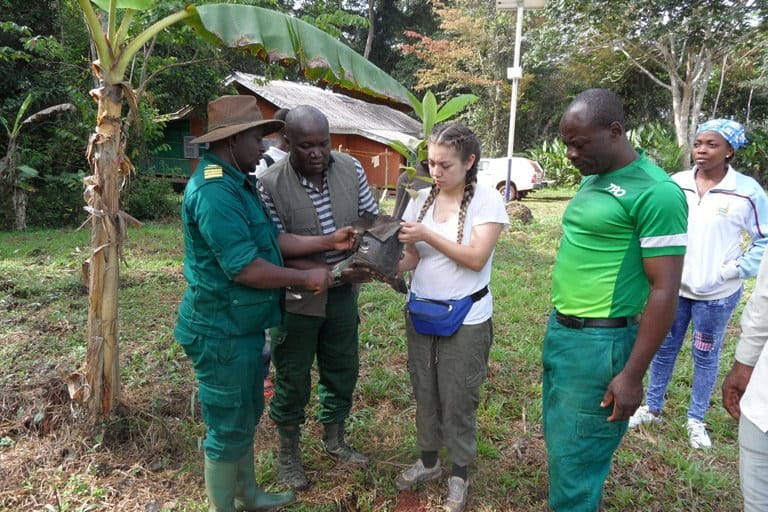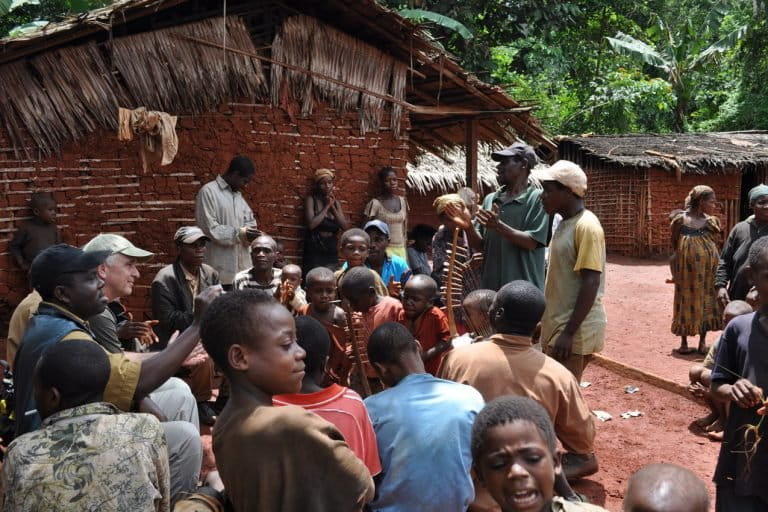- Plantain yields in Cameroon have declined 43 percent in the 20 years since 1991 because of increasing temperatures and dryness.
- Villagers use proceeds from crop sales to pay for higher education, but this income is dwindling.
- As a result, college attendance rates have declined by six months, on average, during this period.
A warming climate and decreased humidity is threatening yields of plantains, a food staple that rural families in Cameroon and elsewhere in Central Africa bank on to pay for their children’s higher education, a new study shows.
Plantain (Musa paradisiaca), a kind of cooking banana, is an easy crop for villagers to grow in small backyard plots. Households dispose of organic waste in these plots, creating a rich fertilizer for the trees. Villagers who harvest more plantain than they can eat stake bunches of the fruit in front of their homes to sell to commercial truck drivers on their way to city markets.

From 1991 to 2011, as the region has grown drier and hotter, plantain yields in Cameroon have dropped by 43 percent — this despite a more than threefold increase in the area dedicated to growing the crop, researchers found. During the same period, the average duration of post-secondary school attendance decreased by six months — a decline the researchers said was “tightly linked” to the falling plantain yields.
The lost earnings from selling fewer crops accounted for this trend, the researchers reported recently in the journal Science of the Total Environment. The scientists examined detailed records of crop production, climate patterns and social and educational demographics across Cameroon to reach this conclusion.
“I do research and calculations all the time,” said Trevon Fuller, lead author and assistant adjunct professor in the Center for Tropical Research at the University of California, Los Angeles (UCLA). “You almost never see a statistical significance that strong. It was compelling.”

Throughout Cameroon, plantain is prepared many ways: frying or boiling green plantain, letting them ripen, or drying and pounding them into a couscous or eaten with eggs and beans.
Plantain grows best in Cameroon’s southern regions. “In these areas, people produce plantain to send their kids to school,” said Eric Nana, associate coordinator of the Higher Institute of Environmental Sciences at the University of Yaoundé I in Cameroon, who was not involved in the study. “But it is not just plantain; they diversify and cultivate many things.”
The income earned from selling plantain and other crops, including taro and cassava, and hunting small game allows rural families to send their children to college. Such education is expensive for Cameroonian villagers, who earn between $40 and $50 a month. Crop earnings pay for tuition, books and school supplies, as well as housing and internet for those attending college in Cameroon’s larger cities.
But the relentless climate trends in Central Africa threaten this small-scale agriculture. The researchers project that by 2030, as crop sales dwindle further, Cameroonian families will be able to afford fewer than two years of higher education, from an average 2.76 years in 1991.
With rural fields producing less plantain, villagers have cut down more forest to expand their farmland. “People realize a loss in yields, but they don’t know how to link it together with climate … [so] they expand,” said Kevin Njabo, a report coauthor and associate director for the Center for Tropical Research at UCLA.

Coffee, cacao and bananas are key exports. But according to the scientists, farmers in Cameroon would prefer not to grow cacao or coffee. These crops are heavily regulated by the government-run Cameroon Development Cooperation, which dictates the prices of crops sold to the U.S. and Europe.
“They don’t even eat chocolate, so they don’t want to grow cacao,” Njabo said. “You see why [they want to grow] plantain, bush mango and safou. Farmers like to produce crops they have a say on, Njabo says, and what their families can use and consume.
Researchers are working to identify plantain varieties that are resilient to climate change. New cultivars bred from tissue culture will create rural centers with “mother plantations” for villagers to collect offshoots to plant in their fields.
Still, the authors call for further investment in crop-breeding programs to help Cameroon adapt to climate change.
“This is very nice research we are doing, but five years go by fast,” Njabo said. “We don’t have enough resources to keep the process going.”

Citation:
Fuller, T. et al. (2018). Climate warming causes declines in crop yields and lowers school attendance rates in Central Africa. Science of the Total Environment. 610-611: Pages 503-510. https://doi.org/10.1016/j.scitotenv.2017.08.041 .
Anna Katrina Hunter (@AKatrinaHunter) is a graduate student in the Science Communication Program at the University of California, Santa Cruz. Other Mongabay stories produced by UCSC students can be found here.
Editor’s note: on January 2, 2018 we amended the caption under Trevon Fuller’s image to “backyard banana” from “backyard plantain”.